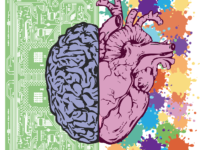Telepathy may no longer be pseudoscience. New technological frontiers are pushing the boundaries of human capability, edging scientific fiction closer to scientific reality. One such feasible experience is direct brain-to-brain collaboration. In 2015, researchers at the University of Washington explored such information exchange but were limited by the need for physical interaction with interfaces (taking away from its “telepathy”) and a maximum of merely two participants. The same team has now revolutionized this technology, attracting media attention even before publishing their work in April 2019.
BrainNet is claimed to be “the first multi-person non-invasive direct brain-to-brain interface (BBI) for collaborative problem solving.” The interface combines electroencephalography (EEG), a method to record electrical activity of the brain, and transcranial magnetic stimulation (TMS), a procedure using magnetic fields to stimulate nerve cells in the brain, to non-invasively record brain signals from the scalp and deliver information through visual cortex stimulation. It allows three humans to collaborate on a task using direct communication between their brains. In their 2019 study, researchers describe the roles of two “Senders” and one “Reciever” in integrating information for decision-making. Senders, whose brain signals are decoded using real-time EEG analysis, convey decisions of “yes” or “no” by controlling a moving cursor using visually-evoked potentials. The cursor position provides a live visualization of their translated brain activity when making decisions. In the study example, a Sender’s decision is decoded to determine whether or not to “rotate a block in a Tetris-like game before it is dropped to fill a line” by focusing on different lights on the screen. Both Senders’ decisions are then transmitted via the Internet to the brain of the Receiver, who does not see the game screen.
BrainNet could be comparable to an express pass for communication.
Once it reaches the Receiver, this transmitted information is compared with the Receiver’s predetermined magnetic stimulation levels associated with the binary “Rotate” and “Do Not Rotate” decisions. Magnetic stimulation enables the Receiver to interpret both decisions, prompting the use of an EEG interface to decide whether to turn the block or preserve its orientation.
A second round of the game acts as a chance for Senders to evaluate the Receiver’s decision and send feedback to the Receiver’s brain. This way, the Receiver can change a possibly incorrect decision made initially. When five groups performed this collaborative task, they demonstrated an average accuracy of 81.25 percent. Despite this relatively small sample size, the accuracy and outcome have exciting potential for a multitude of applications.
When explained through technological interactions with biology, a seemingly paranormal process comes together in clear steps. Now that this is a reality with widely used EEG and TMS methods, BrainNet could be comparable to an express pass for communication. According to an article from UW News, since their initial breakthrough in 2015, the team has been exploring “brain tutoring,” which would transfer signals from a healthy brain to one that is developmentally impaired. Similarly, it could also have the potential to transfer knowledge from teachers to students. Along with this endeavor, the team had also reported an interest in transmitting brain states, such as from the state of a focused student to one with ADHD. “When the non-ADHD student is paying attention, the ADHD student’s brain gets put into a state of greater attention automatically,” said co-author Chantel Prat, a faculty member at the Institute for Learning & Brain Sciences and a UW associate professor of psychology. Though the team hopes to stimulate future BBIs within a “social network” and similar collaborative applications for problem solving, the paper does not mention other uses.
As technology continuously expands, ethical discussions become especially important when involving human subjects.
The density of complications in further experiments, especially with adding brains interacting through the Internet, can pose communication dilemmas. BBIs have potential with multiple specific uses, but their very recent development comes with unresolved ethical issues, including “autonomy, privacy, agency, accountability, and identity,” according to a Frontiers in Neuroscience article. The future use and development of this technology must be carefully considered before continued research. BrainNet researchers are working to address the ethical issues of such brain augmentation research by developing protocols for privacy protection. As technology continuously expands, ethical discussions become especially important when involving human subjects.
Image Source: Pixabay






